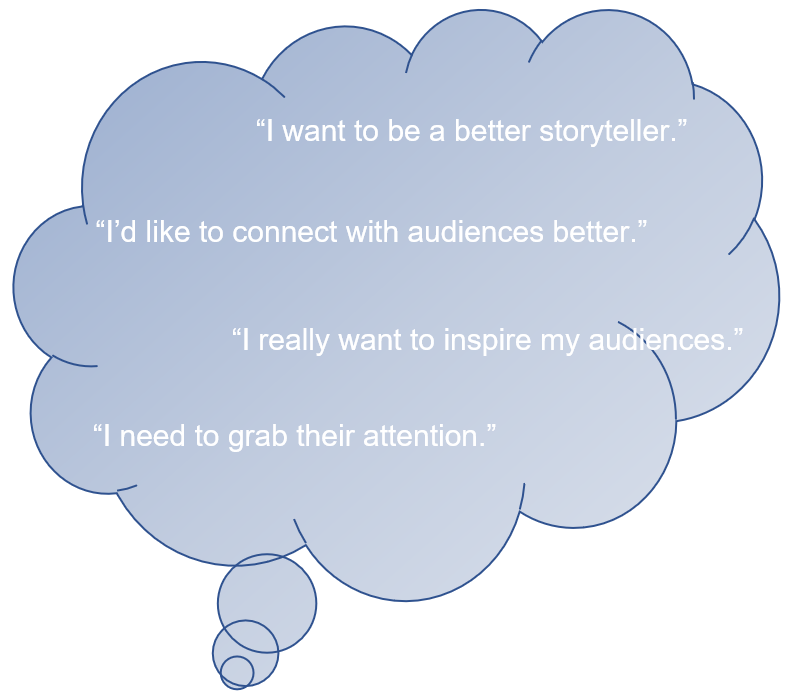SmartMouth Talks!
New Agey Advice for Nervousness
 Let’s cut to the chase on nerves and public speaking by first dispensing with the platitudes we typically hear on the subject.
Let’s cut to the chase on nerves and public speaking by first dispensing with the platitudes we typically hear on the subject.
It’s not enough for you to know that the nervousness you feel before a presentation is your adrenaline getting you ready to do well. That doesn’t really help you, does it?
It’s also not enough to know that literally everyone feels the same way in the first two minutes of a presentation. That’s not helpful either, right?
Or that you just shouldn’t worry about it, you’ll do fine. Not very helpful.
Hearing these attempts to rationalize your experience is akin to being terribly sick with the flu and hearing “it’s a really bad flu season this year,” or “it’s been making the rounds, everyone has it.” Those may be true statements but they’re not a cure for your body’s misery.
Given that there’s also no cure for nerves in public speaking, I’d like to offer some new agey advice, a new angle on an old problem. Here are four ways to create your own zen space while delivering a presentation – keeping you present, at peace, and minimizing unnecessary distractions:
Use your breath. Two steps: 1) Deep breath in. 2) Nice, long exhale out. Sounds silly but it’s real. A good long exhale releases tension in your body, which can make you feel better. Never mind specifics about what to do with your abs or lungs, just take some deep breaths and let out a few good, long exhales. It will relieve and release the tension you feel. Repeat, as necessary.
Use your energy. Focus on your audience rather than on yourself. I mean really stop thinking about yourself. Give them, not yourself (and all your crazy nervous thoughts about forgetting what you want to say or what people are thinking about you), your energy. Turn your attention to them, look at them, move closer to them, talk to them. Surrender your attachment to how well you’re doing or to your material. Instead, connect with THEM.
Set an intention. Set an intention for yourself by imagining ahead of time the type of speaker you want to be in the room – e.g. relaxed, conversational, commanding, confident, approachable, entertaining. Picture yourself being that speaker. Your intention becomes a goal, an ideal, you will be setting for yourself and gives you positive imagery to use as a guide while you speak.
Be mindful. Use mindfulness to acknowledge and accept your nervousness, being gentle and compassionate with yourself, rather than push it away or deny it. Resistance creates suffering. Don’t resist, simply accept. Know that your nerves will accompany you on this journey that is your presentation. It’s natural, it’s you, it’s okay. One of the definitions of zen is to be relaxed and not worrying about things you cannot change.
Taken all together – breathing, turning yourself and your attention over to the audience, visualizing an ideal, and accepting rather than resisting your nerves – might not be a cure but employing these techniques over time will make your public speaking nerves more tolerable initially and then eventually, totally manageable.
Om.
Your Passion Can Go a Long Way Toward Building Connection

Do any (or maybe all) of these goals sound familiar?
When I reflect on my SmartMouth years, and all that I’ve learned from working with an incredibly diverse and absolutely fascinating client base, I would have to say the ultimate game-changer and life-saver for speakers coincidentally comes from the organ we can’t live without … our hearts. 
Consider a few common presentation situations:
Hostages. When people choose to be in the room for your presentation, you have a naturally more attentive audience. When people have not chosen to be in the room and are what I call hostages, it creates special challenges around grabbing and holding attention. Without question, though, a speaker who is passionate and energized about the topic will have a much better chance of grabbing and holding attention even when the audience is only mildly interested in the topic or, worse, not interested at all. With an impassioned delivery, a room of hostages will leave with a good impression of the speaker at the very least.
Presenting Up. Presenting to people who may be more knowledgeable or experienced than you can be daunting. Capturing their attention is hard. Wanting to impress them feels urgent. Yet they know more than you do. So how on earth are you supposed to hold their attention? Honestly, the best thing you can do is to open your heart, be vulnerable, transparent, and excited. Let your audience in, engage them with your eagerness for your work and where you are in it. It will be infectious.
Dry Material. Let’s face it, some presentations deal with material that is dry. Period. If you can share a story – an anecdote, example, or case study – it will do two things. First, it will illustrate the importance or usefulness of your dry material. Second, it will animate your voice and body, bringing out even the most latent passion. If you don’t have any stories to add color, then think about (and rehearse!) infusing your delivery with energy and physical animation, demonstrating a keen interest in or commitment to your topic, and/or telling the audience how genuinely pleased you are to be speaking with them and thank them graciously for their attention to the dry material.
When you make a presentation, you’re hoping to generate interest in your topic. Passion is simply a demonstration of your own interest in the topic. If you want others to be interested, I think it’s only fair that it begins with you. Don’t fake your passion, you don’t have to. Tap into it, it’s very likely close to the surface and accessible to you!
Keep stage fright a private matter while you’re speaking on a public stage!
Want to Replace Your Public Speaking Fear with Confidence?
Nerves
Toothbrush Reminder
 I have it all set up. The camera guy is looking through the lens of his TV studio camera, which is set on a tripod and fixed on the two chairs that face each other. The big-screen monitor for watching instant replays is next to the two chairs.
I have it all set up. The camera guy is looking through the lens of his TV studio camera, which is set on a tripod and fixed on the two chairs that face each other. The big-screen monitor for watching instant replays is next to the two chairs.
The young NBA player walks into the room after practice. He has showered and dressed in his team sweats, and while everyone else has gone home for the afternoon, he has agreed to submit to some one-on-one media training in advance of what promises to be a busy season on the floor. He’s barely a man in chronological age, but he’s physically huge, at just under seven feet tall. We shake hands; he sits down. I ask him if he’s ready to begin. He says he is.
The camera is rolling. I hand him an ordinary toothbrush. He looks at me, perplexed, clearly thinking, This is not what I agreed to do for the next two hours.
I ask him only a few questions about the toothbrush: What is that? What do you do with it? Do you like it? How often do you use it? What do you like about it?
He answers haltingly and offers simple, one-word responses.
Then we’re done with the exercise. We watch the instant replay of his “toothbrush interview,” and finally I explain the method behind my madness.
I do the toothbrush exercise with many of my clients, both athletes and executives. It is a defining and memorable exercise, and it is always totally unexpected . . . but not always well received, at least initially. After all, what does a toothbrush have to do with sports or, for that matter, with communicating?
Nothing. But it has everything to do with being able to think about your audience, be yourself, be nice, get to the point, and be prepared for all of the above.
The lesson of the toothbrush exercise is that no matter how mundane, obvious, or self-explanatory the questions or issues are, you need to be prepared at all times to address your audience in a positive, sincere, and robust manner. And there’s nothing more mundane, obvious, or self-explanatory to have to talk about than a toothbrush.
[Excerpted in part from Jock Talk: 5 Communication Principles for Leaders as Exemplified by Legends of the Sports World, www.jocktalkbook.com]
Once Upon a Time
 Stories – or anecdotes, examples, case studies – are the absolute best way to illustrate a point, even in a business presentation.
Stories – or anecdotes, examples, case studies – are the absolute best way to illustrate a point, even in a business presentation.
When crafted well, they illustrate and support your messages better than anything else. Stories make an emotional connection to your audience that sticks with them long after you finish talking.
Here are 3 rules of thumb that apply to using stories in your communications:
1. STORIES NEED TO DIRECTLY SUPPORT A POINT. In other words, you may have a favorite story that you love to tell, and that’s great, but it must be constructed in a such a way that it works its way to a “punch line” that reinforces the message point you are trying to support. You can’t assume the audience will make that connection on their own, you have to spell it out and tie it together for them.
2. PREPARATION IS ABSOLUTELY NECESSARY. Rather than simply reminding yourself to tell a certain story during your presentation, you need to map out the story to avoid getting lost in the details while telling it (every story has more details than you have time to share!). I have watched too many speakers derail a perfectly good 15-minute presentation by telling a story that went on and on until – before they knew it – an additional 10 minutes of air time had been consumed.
3. SIMPLE IS MORE EFFECTIVE THAN COMPLICATED. This is true of most communications but certainly true of stories – despite the temptation to “spin a yarn” for your audience. Unless you’re a comedian or a professional storyteller, you’ll want to keep your stories simple.
Keeping them simple means paring down and prioritizing the detail. Think about composing your stories in this 3-3-3 format:
-
3 sentences describing the situation;
-
3 sentences revealing the dramatic tension (e.g. something unexpected, complications, competing factors); and
-
3 sentences outlining the resolution, which should help you tie back – in that punch line kind of a way – to the point you were illustrating.
And finally, be sure to cue your audience when you’re beginning and ending a story. For those in the audience who might not be paying close attention, you have the opportunity to reignite interest with your own appropriate versions of “Once upon a time” and “The end” – those timeless story cues that signal the open and close of something special.
I Was With You Until …
 When a colleague or friend asks you for feedback on a presentation, do you find yourself glossing over the truth? Do you offer actual constructive criticism, or do you hold back in favor of sparing the speaker’s feelings? Maybe you’re not sure exactly what to say or how to say it?
When a colleague or friend asks you for feedback on a presentation, do you find yourself glossing over the truth? Do you offer actual constructive criticism, or do you hold back in favor of sparing the speaker’s feelings? Maybe you’re not sure exactly what to say or how to say it?
I think we’ve all been in this position at least once. It’s easy to give kudos when a speaker does a spectacular job, but more often than not, there’s something we saw or heard that could have been better. What we say and how we say it often depends on our relationship to the speaker – friend, colleague, or even boss.
Regardless of the relationship, below is a two-step approach to giving constructive feedback.
1. Decide who you are.
You might begin your feedback with either of these two options:
As your colleague/friend, I …
As an audience member, I …
Depending on what you want to tell them, you can be their colleague/friend, or you can distance yourself a little bit and talk about your observation or experience as an audience member.
As “colleague/friend,” you’re more likely to soft-pedal things a little and mix in what you liked with what you didn’t like so much. That’s perfectly okay as long as you’re truthful.
As “audience member,” you’re able to serve up the harder feedback from the more objective vantage point of being a general audience member versus speaking solely for yourself.
2. Make it specific.
Rather than “Well, that wasn’t your best, I’ve seen you deliver that presentation better” or “You were great up there, loved it,” think about feedback that drives toward specifics the speaker can use to improve their presentation. For example, consider these:
My mind started to drift right around …
I was hoping you would have …
I understood X, but wasn’t sure where Y fit in …
I loved the story you told, but I wasn’t sure what point it supported …
You really had me when you started talking about …
I noticed people nodding with you when you …
I was with you until …
The reality is that being a good speaker and presenter is a journey. Like with any good journey, speakers need guidance and company along the way. As the one giving the feedback, you don’t want to be insincere and offer flattery for a mediocre presentation, nor do you want to tell someone they completely blew it. Instead, share specifics the speaker can use to learn from, fix or enhance. At the end of the day, you were probably “with them until …” and even that alone would be helpful for the speaker to know!
How to Watch the Olympic Games
 This Olympic year, more than any other, our Team USA athletes are under intense pressure.
This Olympic year, more than any other, our Team USA athletes are under intense pressure.
As if it’s not stressful enough to qualify and make the team ordinarily, members of Team USA have trained, traveled and competed during a global pandemic to earn their spots this year. Then, in preparation for, and while in Beijing, they must adhere to strict Covid protocols, including constant testing, to keep themselves and their teammates and competitors healthy for competition. On top of that, they have the usual random drug testing and, much less usual, their own government is boycotting the Games due to the host country’s human rights violations.
It’s a lot. It’s especially a lot if your sole focus is supposed to be on your sport.
While the athletes are laser-focused on their competitions, as well as on enjoying the Olympic experience, one other pressure is unavoidable: the presence of the media. The media, both print and broadcast, come with the territory of the Olympic Games. And while not every athlete is a draw for the mainstream media, every athlete certainly is a draw for their hometown media at the very least.
The media will be interested to hear everything from the athletes’ feelings about their competitions and venues to how they like the food and everything in between. “Everything in between” is where it can get dicey; for example, at these Games, that could include questions about the U.S. diplomatic boycott, China’s human rights record, the situation with Peng Shuai, or even air quality and environmental concerns. Again, it’s a lot.
So, as you watch the Games this month, and the Paralympic Games next month, enjoy the spectacular athletic feats you see. But also pay attention to the public speaking feats as well. As with any high-profile spokesperson or ambassador, we should be seeing a demonstration of the following 5 principles from Jock Talk in the interviews they give:
Audience-centricity – Are they making it interesting and accessible to the audience, or are they using jargon and making it hard to follow or understand?
Transparency – Are they being as open as possible about, and letting us into, their experience? In other words, are they being as open and sincere about their feelings and emotions as they are about the facts?
Graciousness – Are they taking the high road when asked about a disappointing performance or about their host country? Are they displaying good sportsmanship and are they representing their teams and country well?
Brevity – Are they getting to the point or rambling in their responses to questions? Are they able to end the interview once they’ve said everything they have to say?
Preparedness – Are they prepared to address victory as well as defeat, or do they seem to be caught off guard? Are they consistent in how they present themselves and “on brand” or on point with their responses?
Enjoy watching the Games this month and next and, while you’re at it, learn from these athletes’ performances at the mic. Hopefully, both on and off the field of play, Team USA will inspire us to be better!
Preparing for Our Next Normal
 Well, here we are <insert tentative smile> at the onset of another new year.
Well, here we are <insert tentative smile> at the onset of another new year.
As they typically are, this new year is filled with the promise, hopefulness, and opportunities of a new start. Yet, at the same time, many of us feel uncertain, limited, and confused by the same constraints this winter as we did last year at this time.
The pandemic is obviously with us. It’s moving into the new year with us and likely beyond. So it’s not really a new normal we need to concern ourselves with now, it’s the next normal we need to anticipate. While the situation around us is constantly evolving, and we’re hastily evolving along with it, the key question is: Do we have everything we need to be successful in the next normal?
Sure, we’ve adapted and taken advantage of tools and resources we always had access to but hadn’t yet mastered or maximized. One of those, of course, is virtual meetings and virtual meeting platforms. Zoom has become the Kleenex or Xerox of virtual meeting platforms. But I think we all can agree it’s very 2020 and so it’s the old new normal. And while there’s a huge adoption of, and so many improvements to, virtual platforms like Zoom, there’s also still a ton of fatigue. The reality for all of us is that engagement in virtual meetings is still elusive.
What’s missing then? What can we do to be better, more effective, less draining to others?
Communication. How we communicate, how much we communicate, when we communicate, how we listen, how we engage, how we execute on our goals for a meeting. Communication skills and styles need to be the sharpest tools in the toolbox in order to be ready and be successful in the next normal.
Getting there isn’t or shouldn’t be difficult. For starters, there are the five communication principles I espouse in Jock Talk: 5 Communication Principles for Leaders as Exemplified by Legends of the Sports World. They are audience-centricity, transparency, graciousness, brevity and preparedness. All five are critical, but clearly brevity is the one in shortest supply.
Take it upon yourself to sharpen your communication skills in 2022. Read the book (or listen to it) or reach out for coaching. In many cases, your exposure to others, internally and externally, will be one-dimensional … on a screen. Let’s make sure the impression you leave isn’t like the screen … flat.
Welcome to 2022!



